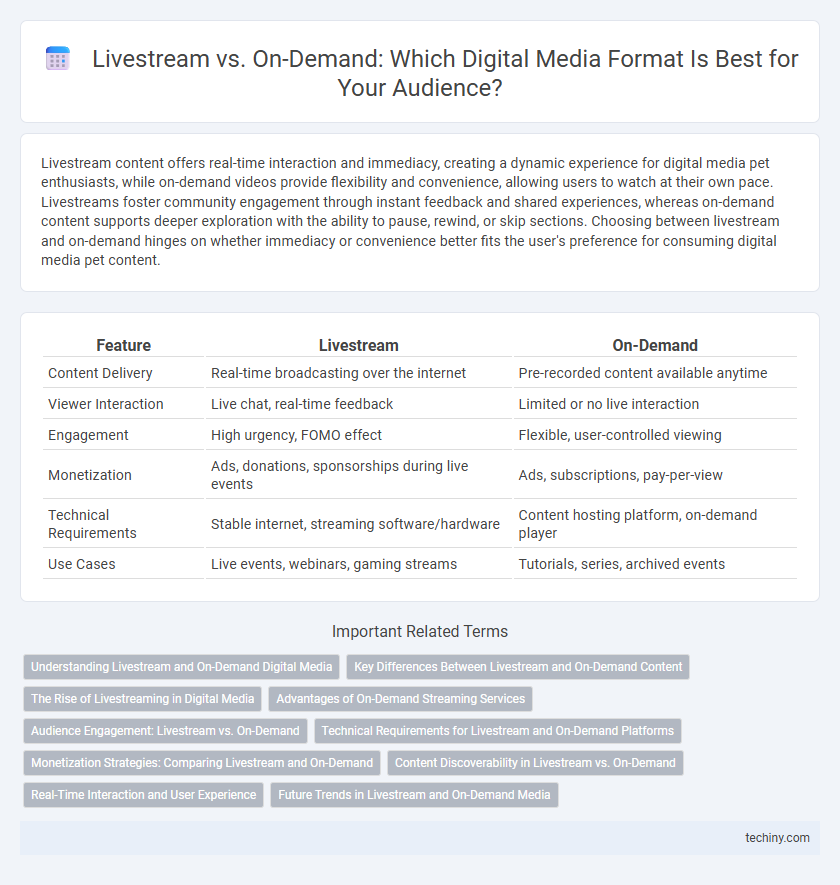Livestream content offers real-time interaction and immediacy, creating a dynamic experience for digital media pet enthusiasts, while on-demand videos provide flexibility and convenience, allowing users to watch at their own pace. Livestreams foster community engagement through instant feedback and shared experiences, whereas on-demand content supports deeper exploration with the ability to pause, rewind, or skip sections. Choosing between livestream and on-demand hinges on whether immediacy or convenience better fits the user's preference for consuming digital media pet content.
Table of Comparison
| Feature | Livestream | On-Demand |
|---|---|---|
| Content Delivery | Real-time broadcasting over the internet | Pre-recorded content available anytime |
| Viewer Interaction | Live chat, real-time feedback | Limited or no live interaction |
| Engagement | High urgency, FOMO effect | Flexible, user-controlled viewing |
| Monetization | Ads, donations, sponsorships during live events | Ads, subscriptions, pay-per-view |
| Technical Requirements | Stable internet, streaming software/hardware | Content hosting platform, on-demand player |
| Use Cases | Live events, webinars, gaming streams | Tutorials, series, archived events |
Understanding Livestream and On-Demand Digital Media
Livestream digital media delivers real-time content to viewers, fostering immediate interaction and engagement through live chats and instant feedback. On-demand digital media allows users to access pre-recorded content at their convenience, offering flexibility and control over viewing schedules. Both formats serve distinct audience needs, with livestream prioritizing immediacy and communal experience, while on-demand emphasizes accessibility and personalized consumption.
Key Differences Between Livestream and On-Demand Content
Livestream content is broadcast in real-time, creating immediate viewer engagement and interactivity, while on-demand content offers flexibility by allowing users to watch anytime, ensuring convenience and personalized viewing. Livestreams typically require stable internet connectivity with minimal latency, essential for synchronous audience interaction, whereas on-demand videos are pre-recorded and can be downloaded or streamed without urgency. Audience behavior differs as livestreams generate a sense of community and urgency, driving real-time participation, whereas on-demand content supports binge-watching and content revisiting at the viewer's own pace.
The Rise of Livestreaming in Digital Media
Livestreaming in digital media has surged with platforms like Twitch, YouTube Live, and Facebook Live attracting millions daily, driven by real-time interaction and authentic content experiences. Brands leverage livestreaming to boost engagement, enhance customer trust, and create immediate call-to-action opportunities that on-demand videos often lack. This growth is fueled by advances in high-speed internet, mobile technology, and the increasing demand for instant, interactive content consumption.
Advantages of On-Demand Streaming Services
On-demand streaming services offer the advantage of flexibility, allowing viewers to watch content anytime and anywhere without being tied to a broadcast schedule. They provide extensive content libraries, enabling users to binge-watch series or revisit favorite shows at their convenience. Personalized recommendations driven by AI algorithms further enhance the user experience by curating content based on individual preferences and viewing history.
Audience Engagement: Livestream vs. On-Demand
Livestream content drives higher audience engagement by enabling real-time interaction, fostering a sense of community and immediacy that on-demand cannot replicate. Audience participation through live chats, polls, and Q&A sessions increases viewer retention and emotional investment. On-demand content offers flexibility but typically sees lower engagement rates due to the lack of interactive elements and scheduled viewing.
Technical Requirements for Livestream and On-Demand Platforms
Livestream platforms require low-latency streaming protocols such as RTMP and HLS, robust real-time encoding, and high bandwidth to ensure minimal delay and smooth playback. On-demand platforms rely on adaptive bitrate streaming (ABR) and efficient content delivery networks (CDNs) to optimize video quality and buffering based on user internet speed. Both platforms necessitate scalable cloud infrastructure, but livestream systems demand advanced synchronization and live transcoding capabilities to handle concurrent viewers effectively.
Monetization Strategies: Comparing Livestream and On-Demand
Livestream monetization leverages real-time viewer engagement through mechanisms like pay-per-view, virtual tipping, and live sponsorships, driving immediate revenue while fostering a sense of community. On-demand content enhances monetization by offering subscription models, targeted advertising, and content bundling, optimizing long-term value through repeated access and personalized user experiences. Both methods require tailored strategies to maximize audience retention and revenue streams in the competitive digital media landscape.
Content Discoverability in Livestream vs. On-Demand
Livestream content offers real-time engagement but often faces challenges in long-term discoverability due to its fleeting nature and lack of indexed metadata. On-demand content benefits from structured categorization, metadata tagging, and search engine optimization, making it more accessible for users seeking specific topics or segments after the initial broadcast. Platforms that integrate automated transcription and chapter markers enhance content discoverability in both livestream archives and on-demand libraries, improving user retention and search relevance.
Real-Time Interaction and User Experience
Livestream offers unparalleled real-time interaction, enabling viewers to engage directly with content creators through live chats, polls, and instant feedback, enhancing user experience with a sense of community and immediacy. On-demand content provides flexibility and convenience, allowing users to access media anytime, but lacks the spontaneous engagement and shared experience inherent in livestream formats. Platforms like Twitch and YouTube Live capitalize on real-time interaction to drive higher viewer retention and foster dynamic content consumption compared to traditional on-demand services.
Future Trends in Livestream and On-Demand Media
Future trends in digital media emphasize the convergence of livestream and on-demand content, driven by advancements in AI-powered personalization and interactive technologies. Enhanced viewer engagement through real-time data analytics and augmented reality features will redefine user experiences, making livestreams more immersive while on-demand platforms offer tailored content recommendations. The integration of blockchain for secure content distribution and monetization models is expected to further transform the landscape of digital media consumption.
Livestream vs On-Demand Infographic

 techiny.com
techiny.com